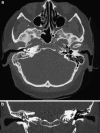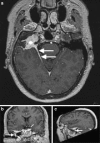Primary temporal bone secretory meningioma presenting as chronic otitis media
- PMID: 18172659
- PMCID: PMC2440930
- DOI: 10.1007/s00405-007-0531-6
Primary temporal bone secretory meningioma presenting as chronic otitis media
Abstract
We report an extremely rare case of a secretory meningioma primarily involving the temporal bone. A 56-year old female patient presented to us with a history of a chronic otitis media and unilateral hearing loss. Diagnostic investigations revealed a tumor arising from the temporal bone without signs of intracranial involvement. Histopathological examination showed a meningioma of the secretory type. The tumor was partially resected and serial imaging at follow-up revealed no extension of the tumor. No new symptoms developed 1 year after surgery. Secretory meningioma is a rare meningioma subtype and extracranial presentation in the temporal bone is very unusual. We present the first case of a primary temporal bone secretory meningioma in the otorhinolaryngological literature. As radical as possible surgical excision with serial imaging at follow-up is recommended.
Figures



References
-
- Gagnon NB, Lavigne F, Mohr G, Guerard MJ, Bouvier G. Extracranial and intracranial meningiomas. J Otolaryngol. 1986;15(6):380–384. - PubMed
MeSH terms
LinkOut - more resources
Full Text Sources
Research Materials

